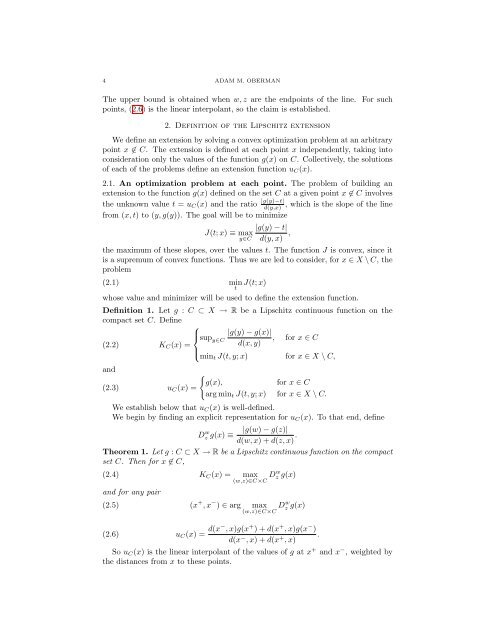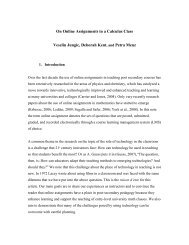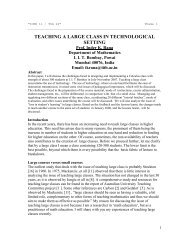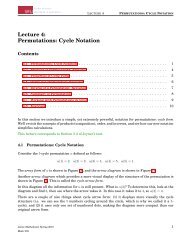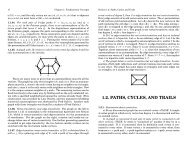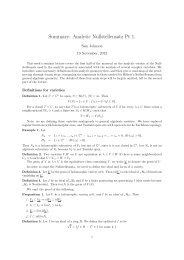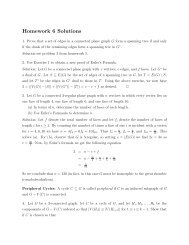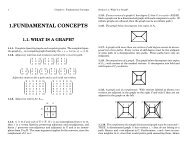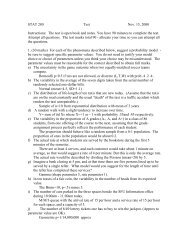AN EXPLICIT SOLUTION OF THE LIPSCHITZ EXTENSION ...
AN EXPLICIT SOLUTION OF THE LIPSCHITZ EXTENSION ...
AN EXPLICIT SOLUTION OF THE LIPSCHITZ EXTENSION ...
You also want an ePaper? Increase the reach of your titles
YUMPU automatically turns print PDFs into web optimized ePapers that Google loves.
4 ADAM M. OBERM<strong>AN</strong><br />
The upper bound is obtained when w, z are the endpoints of the line. For such<br />
points, (2.6) is the linear interpolant, so the claim is established.<br />
2. Definition of the Lipschitz extension<br />
We define an extension by solving a convex optimization problem at an arbitrary<br />
point x ∉ C. The extension is defined at each point x independently, taking into<br />
consideration only the values of the function g(x) on C. Collectively, the solutions<br />
of each of the problems define an extension function u C (x).<br />
2.1. An optimization problem at each point. The problem of building an<br />
extension to the function g(x) defined on the set C at a given point x ∉ C involves<br />
the unknown value t = u C (x) and the ratio |g(y)−t|<br />
d(y,x)<br />
, which is the slope of the line<br />
from (x, t) to (y, g(y)). The goal will be to minimize<br />
J(t; x) ≡ max<br />
y∈C<br />
|g(y) − t|<br />
d(y, x) ,<br />
the maximum of these slopes, over the values t. The function J is convex, since it<br />
is a supremum of convex functions. Thus we are led to consider, for x ∈ X \ C, the<br />
problem<br />
(2.1) min<br />
t<br />
J(t; x)<br />
whose value and minimizer will be used to define the extension function.<br />
Definition 1. Let g : C ⊂ X → R be a Lipschitz continuous function on the<br />
compact set C. Define<br />
⎧<br />
⎪⎨<br />
|g(y) − g(x)|<br />
sup y∈C , for x ∈ C<br />
(2.2) K C (x) =<br />
d(x, y)<br />
⎪⎩<br />
min t J(t, y; x) for x ∈ X \ C,<br />
and<br />
(2.3) u C (x) =<br />
{<br />
g(x),<br />
for x ∈ C<br />
arg min t J(t, y; x) for x ∈ X \ C.<br />
We establish below that u C (x) is well-defined.<br />
We begin by finding an explicit representation for u C (x). To that end, define<br />
Dz w |g(w) − g(z)|<br />
g(x) ≡<br />
d(w, x) + d(z, x) .<br />
Theorem 1. Let g : C ⊂ X → R be a Lipschitz continuous function on the compact<br />
set C. Then for x ∉ C,<br />
(2.4) K C (x) = max<br />
(w,z)∈C×C Dw z g(x)<br />
and for any pair<br />
(2.5) (x + , x − ) ∈ arg max<br />
(w,z)∈C×C Dw z g(x)<br />
(2.6) u C (x) = d(x− , x)g(x + ) + d(x + , x)g(x − )<br />
d(x − , x) + d(x + .<br />
, x)<br />
So u C (x) is the linear interpolant of the values of g at x + and x − , weighted by<br />
the distances from x to these points.


